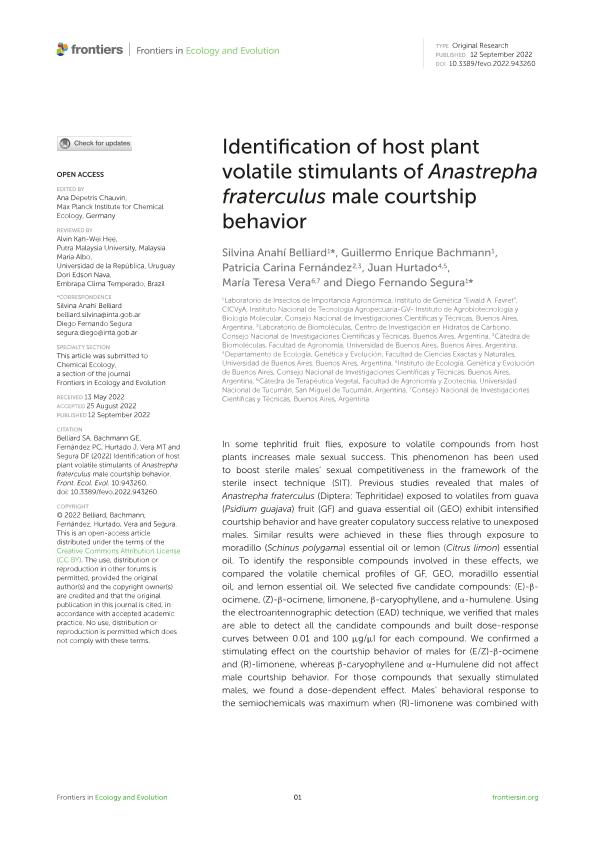Mostrar el registro sencillo del ítem
dc.contributor.author
Belliard, Silvina Anahí

dc.contributor.author
Bachmann, Guillermo Enrique

dc.contributor.author
Fernandez, Patricia Carina

dc.contributor.author
Hurtado, Juan Pablo

dc.contributor.author
Vera, María Teresa

dc.contributor.author
Segura, Diego Fernando

dc.date.available
2023-09-19T12:56:51Z
dc.date.issued
2022-09
dc.identifier.citation
Belliard, Silvina Anahí; Bachmann, Guillermo Enrique; Fernandez, Patricia Carina; Hurtado, Juan Pablo; Vera, María Teresa; et al.; Identification of host plant volatile stimulants of Anastrepha fraterculus male courtship behavior; Frontiers Media; Frontiers in Ecology and Evolution; 10; 9-2022; 1-15
dc.identifier.issn
2296-701X
dc.identifier.uri
http://hdl.handle.net/11336/211975
dc.description.abstract
In some tephritid fruit flies, exposure to volatile compounds from host plants increases male sexual success. This phenomenon has been used to boost sterile males’ sexual competitiveness in the framework of the sterile insect technique (SIT). Previous studies revealed that males of Anastrepha fraterculus (Diptera: Tephritidae) exposed to volatiles from guava (Psidium guajava) fruit (GF) and guava essential oil (GEO) exhibit intensified courtship behavior and have greater copulatory success relative to unexposed males. Similar results were achieved in these flies through exposure to moradillo (Schinus polygama) essential oil or lemon (Citrus limon) essential oil. To identify the responsible compounds involved in these effects, we compared the volatile chemical profiles of GF, GEO, moradillo essential oil, and lemon essential oil. We selected five candidate compounds: (E)-β-ocimene, (Z)-β-ocimene, limonene, β-caryophyllene, and α-humulene. Using the electroantennographic detection (EAD) technique, we verified that males are able to detect all the candidate compounds and built dose-response curves between 0.01 and 100 μg/μl for each compound. We confirmed a stimulating effect on the courtship behavior of males for (E/Z)-β-ocimene and (R)-limonene, whereas β-caryophyllene and α-Humulene did not affect male courtship behavior. For those compounds that sexually stimulated males, we found a dose-dependent effect. Males’ behavioral response to the semiochemicals was maximum when (R)-limonene was combined with (E/Z)-β-ocimene, but the response was reduced when β-caryophyllene and α-humulene were included, which suggests some sort of negative interaction between them. Our results may contribute to the ongoing development of the SIT in this species.
dc.format
application/pdf
dc.language.iso
eng
dc.publisher
Frontiers Media

dc.rights
info:eu-repo/semantics/openAccess
dc.rights.uri
https://creativecommons.org/licenses/by-nc-sa/2.5/ar/
dc.subject
FRUIT FLIES
dc.subject
LIMONENE
dc.subject
PHEROMONE CALLING
dc.subject
PHYTOCHEMICALS
dc.subject
SEMIOCHEMICALS
dc.subject
STERILE INSECT TECHNIQUE
dc.subject
Β-OCIMENE
dc.subject.classification
Zoología, Ornitología, Entomología, Etología

dc.subject.classification
Ciencias Biológicas

dc.subject.classification
CIENCIAS NATURALES Y EXACTAS

dc.title
Identification of host plant volatile stimulants of Anastrepha fraterculus male courtship behavior
dc.type
info:eu-repo/semantics/article
dc.type
info:ar-repo/semantics/artículo
dc.type
info:eu-repo/semantics/publishedVersion
dc.date.updated
2023-07-06T17:29:54Z
dc.journal.volume
10
dc.journal.pagination
1-15
dc.journal.pais
Reino Unido

dc.journal.ciudad
Londres
dc.description.fil
Fil: Belliard, Silvina Anahí. Instituto Nacional de Tecnología Agropecuaria. Centro de Investigación en Ciencias Veterinarias y Agronómicas. Instituto de Agrobiotecnología y Biología Molecular. Grupo Vinculado Instituto de Genética "Ewald A. Favret" al Iabimo | Consejo Nacional de Investigaciones Científicas y Técnicas. Oficina de Coordinación Administrativa Parque Centenario. Instituto de Agrobiotecnología y Biología Molecular. Grupo Vinculado Instituto de Genética "Ewald A. Favret" al Iabimo; Argentina
dc.description.fil
Fil: Bachmann, Guillermo Enrique. Instituto Nacional de Tecnología Agropecuaria. Centro de Investigación en Ciencias Veterinarias y Agronómicas. Instituto de Agrobiotecnología y Biología Molecular. Grupo Vinculado Instituto de Genética "Ewald A. Favret" al Iabimo | Consejo Nacional de Investigaciones Científicas y Técnicas. Oficina de Coordinación Administrativa Parque Centenario. Instituto de Agrobiotecnología y Biología Molecular. Grupo Vinculado Instituto de Genética "Ewald A. Favret" al Iabimo; Argentina
dc.description.fil
Fil: Fernandez, Patricia Carina. Consejo Nacional de Investigaciones Científicas y Técnicas. Oficina de Coordinación Administrativa Ciudad Universitaria. Centro de Investigaciones en Hidratos de Carbono. Universidad de Buenos Aires. Facultad de Ciencias Exactas y Naturales. Centro de Investigaciones en Hidratos de Carbono; Argentina
dc.description.fil
Fil: Hurtado, Juan Pablo. Consejo Nacional de Investigaciones Científicas y Técnicas. Oficina de Coordinación Administrativa Ciudad Universitaria. Instituto de Ecología, Genética y Evolución de Buenos Aires. Universidad de Buenos Aires. Facultad de Ciencias Exactas y Naturales. Instituto de Ecología, Genética y Evolución de Buenos Aires; Argentina
dc.description.fil
Fil: Vera, María Teresa. Consejo Nacional de Investigaciones Científicas y Técnicas; Argentina. Universidad Nacional de Tucumán. Facultad de Agronomía y Zootecnia. Cátedra Terapéutica Vegetal; Argentina
dc.description.fil
Fil: Segura, Diego Fernando. Instituto Nacional de Tecnología Agropecuaria. Centro de Investigación en Ciencias Veterinarias y Agronómicas. Instituto de Agrobiotecnología y Biología Molecular. Grupo Vinculado Instituto de Genética "Ewald A. Favret" al Iabimo | Consejo Nacional de Investigaciones Científicas y Técnicas. Oficina de Coordinación Administrativa Parque Centenario. Instituto de Agrobiotecnología y Biología Molecular. Grupo Vinculado Instituto de Genética "Ewald A. Favret" al Iabimo; Argentina
dc.journal.title
Frontiers in Ecology and Evolution
dc.relation.alternativeid
info:eu-repo/semantics/altIdentifier/url/https://www.frontiersin.org/articles/10.3389/fevo.2022.943260/full
dc.relation.alternativeid
info:eu-repo/semantics/altIdentifier/doi/http://dx.doi.org/10.3389/fevo.2022.943260
Archivos asociados
